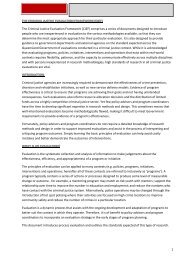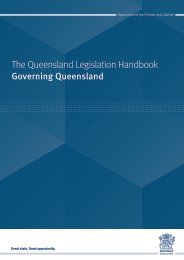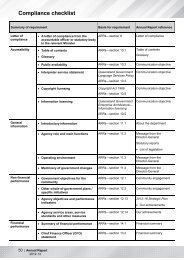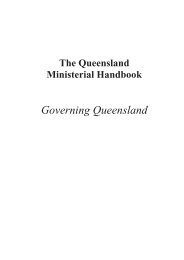Rehabilitative needs and treatment of Indigenous offenders in ...
Rehabilitative needs and treatment of Indigenous offenders in ...
Rehabilitative needs and treatment of Indigenous offenders in ...
You also want an ePaper? Increase the reach of your titles
YUMPU automatically turns print PDFs into web optimized ePapers that Google loves.
What are some <strong>of</strong> the considerations <strong>in</strong> deliver<strong>in</strong>g programs to<strong>Indigenous</strong> <strong>of</strong>fenders? Best-practice literature <strong>in</strong>dicates that rehabilitative programs shouldrespond to risk <strong>of</strong> re-<strong>of</strong>fend<strong>in</strong>g, crim<strong>in</strong>ogenic <strong>needs</strong> <strong>and</strong> <strong>of</strong>fenderresponsivity. Meta-evaluations have shown that rehabilitative programs that utilisecognitive behavioural therapy have a demonstrated effect on reduc<strong>in</strong>grecidivism among participants. Importantly, rehabilitative programs thattarget <strong>of</strong>fender crim<strong>in</strong>ogenic <strong>needs</strong> have been shown to have thehighest impact on reduc<strong>in</strong>g recidivism. There is a paucity <strong>of</strong> evidence-based research on the rehabilitation <strong>of</strong><strong>Indigenous</strong> <strong>of</strong>fenders <strong>in</strong> Australia. The best <strong>in</strong>formation suggests thatrehabilitation efforts should comb<strong>in</strong>e cognitive behavioural therapy withculturally sensitive content <strong>and</strong> delivery modes. Research alsodemonstrates that <strong>Indigenous</strong> <strong>of</strong>fender crim<strong>in</strong>ogenic programs shouldbe high <strong>in</strong> frequency <strong>and</strong> duration.Some researchers have been critical <strong>of</strong> apply<strong>in</strong>g the cognitivebehavioural therapy approach to <strong>Indigenous</strong> <strong>of</strong>fenders. It has beensuggested that promot<strong>in</strong>g self-disclosure <strong>in</strong> a peer group sett<strong>in</strong>gcontravenes <strong>Indigenous</strong> mores <strong>and</strong> can be seen to be associated withsham<strong>in</strong>g. Some <strong>Indigenous</strong> <strong>of</strong>fenders participat<strong>in</strong>g <strong>in</strong> the QCS Internal ServicesDelivery Review reported that they felt shame when discuss<strong>in</strong>gpersonal issues <strong>in</strong> a group context, while others reported benefits <strong>in</strong>be<strong>in</strong>g <strong>in</strong>volved <strong>in</strong> this k<strong>in</strong>d <strong>of</strong> self-disclosure. It is clear that furtherresearch on suitability <strong>of</strong> programs underp<strong>in</strong>ned by the cognitivebehavioural therapy approach for <strong>Indigenous</strong> <strong>of</strong>fenders is required.Other researchers have <strong>in</strong>dicated that <strong>Indigenous</strong> rehabilitation<strong>in</strong>terventions need to be holistic <strong>in</strong> approach <strong>and</strong> attend not only tocrim<strong>in</strong>ogenic <strong>needs</strong>, but the multilayered issues faced by this group.This latter approach is evident <strong>in</strong> the strength-based model that hasbeen implemented <strong>in</strong> other jurisdictions (for example, Heal<strong>in</strong>g Lodges<strong>in</strong> Canada). Although this model is yet to show significant benefits <strong>in</strong>terms <strong>of</strong> reduc<strong>in</strong>g recidivism, it is worth not<strong>in</strong>g that some <strong>Indigenous</strong><strong>of</strong>fenders participat<strong>in</strong>g <strong>in</strong> the QCS Internal Services Delivery Reviewexpressed an <strong>in</strong>terest <strong>in</strong> (re-)connect<strong>in</strong>g with <strong>Indigenous</strong> culture,history <strong>and</strong> heritage. Low literacy <strong>and</strong> numeracy skills among <strong>Indigenous</strong> <strong>of</strong>fenders wereregularly cited as a barrier to participation <strong>in</strong> rehabilitative <strong>in</strong>terventions(<strong>in</strong>clud<strong>in</strong>g crim<strong>in</strong>ogenic programs <strong>and</strong> other educative <strong>and</strong> vocationaltra<strong>in</strong><strong>in</strong>g opportunities).6














